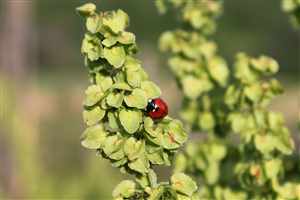Yellow dock (Rumex crispus), Curly Dock
Main Facts about Yellow dock

Using Yellow dock
A non-irritating laxative for constipation. Yellow dock is a kinder, gentler laxative than rhubarb, but use only the smallest amount possible and step up dose carefully to avoid cramping. Tea enhances digestion and improves appetite. Used for liver problems, and arthritis. Also used to clear chronic skin problems like eczema, psoriasis, rash, boils, abscesses. Helps remove sores, pimples and problems from the skin. Applied externally to ulcers, boils, and tumors. In traditional medicine, the root was used as a remedy against internal parasites (tapeworm and roundworm). The whole plant is used for vascular disorders and internal bleeding.Yellow dock is a remedy for: Constipation
Caution!
Curly Dock leaves are somewhat tart due to the presence of high levels of oxalic acid, and although quite palatable, this plant should only be consumed in moderation as it can irritate the urinary tract and increase the risk of developing kidney stones. Fresh root will cause vomiting. Avoid long-term use. Avoid use during pregnancy and while nursing.Cooking with Yellow dock
Whole plant useable. Its young leaves are edible. They should be boiled in several changes of water to remove as much of the oxalic acid as possible or can be added directly to salads in moderate amounts. Once the plant matures it becomes too bitter to consume. Root is most medicinal. It is not boiled, as most roots are. Instead the chopped root is placed in a cup, and boiling water is poured over the roots. Cover and let steep for 30 min. Strain, reheat and drink. the root can be mashed and used as a poultice and salve, or dried and used as a dusting powder. Can be mixed with sage as a tea and consumed and also put in a bath. If you want to make a really good healing cleanser, mix Yellow dock with burdock, dandelion, and even some nettles.How to grow Yellow dock
Curly Dock grows in a wide variety of habitats, including disturbed soil, waste areas, roadsides, fields or meadows, shorelines, and forest edges. It is often seen in disturbed soils at the edges of roadsides, railway beds, and car parks. Gather dock roots in the fall after the seeds mature. If you cultivate dock in your garden, it will need a deep, porous garden bed.| Yarrow |
Yohimbe
|